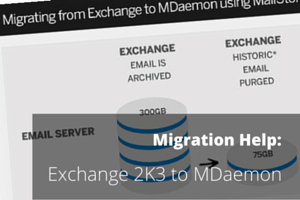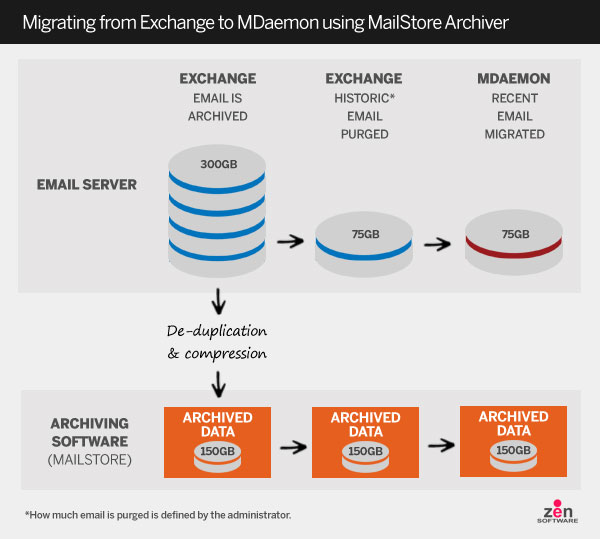21 Sep A Fresh Start: 3 Ways to Migrate from Exchange 2003 to MDaemon
 One the biggest challenges you’re likely to come across if you’re considering upgrading from Exchange 2003 to an alternative email platform, is how to move the colossal volumes of email you’re likely to have amassed over the years.
One the biggest challenges you’re likely to come across if you’re considering upgrading from Exchange 2003 to an alternative email platform, is how to move the colossal volumes of email you’re likely to have amassed over the years.
It can be a daunting prospect, but if you’re moving to MDaemon Messaging Server, the process is made considerably more simple than it might otherwise be, thanks to a free ‘MDMigrator’ utility that’s bundled in the installation folder.
It’s also possible to couple this migrator tool with an archiving solution like MailStore Server (special offer here for Exchange 2003 users), giving you a great opportunity to start afresh and to get the more unwieldy of mailboxes under control.
In this post I’ll take a look at each of the approaches…
Option 1: Migrate everything using the free MDMigrator tool
If you want to move absolutely everything across from your Exchange 2003 installation, straight to MDaemon, the free MDMigrator tool is a great way to do it and will save you countless hours by automating the process almost entirely.
The free MDmigrator will import and migrate:
- User accounts
- Email messages
- Calendar entries
- Contacts, tasks and notes
- Public folders
- Distribution lists
It copies all of the mailboxes from the selected server, creates MDaemon mailboxes for each user and then imports all of their mail, contacts, task, notes, and calendar data. Any distribution lists that are found are copied from address books and are imported as mailing lists in MDaemon.
Brad Wyro, Technical Training Specialist does a much better job of explaining the process than I can in this YouTube video:
There’s also a knowledgebase article on Migrating from Exchange 2003 which walks you through the process step by step.
Option 2: Archive with MailStore, migrate recent messages with MDMigrator
An alternative option is still to use the MDMigrator tool but instead of using it to move all of your email, you archive it beforehand with an archiving solution such as MailStore Server.
This is the one we recommend whenever possible as being a good compromise.
The role of MailStore (archive and ‘slim’ down mailboxes)
- Quick way to archive large volumes of email – The key benefit of MailStore is that it provides a fast and efficient method of archiving large volumes of email but without limiting what users have access to.
- Ensures users have fast access to all email – If a user wants to open email, they simply search or browse for it using from within Outlook using an integrated plug-in (there’s also a web version and phone app).
- Compresses and de-duplicates – The process of archiving also compresses attachments and de-duplicates messages so you should expect approximately a 50% space saving on the original data store.
- Deletes historic email from your server – with all email safely archived, MailStore can purge however much email you choose from Exchange. Typically this would be everything but the last 6-12 months’ so there’s much less to move.
- Manages MDaemon on an ongoing basis – although we’re using MailStore for the migration process, it will continue to archive mail once the migration is complete.

The role of the MDMigrator
In this scenario the MDMigrator is performing the same function as it was in ‘Option 1‘ and migrating the users, the calendar, contacts etc. (MailStore only handles email) however this time the bulk of the email has been archived and the mailboxes are much smaller than they otherwise would be.
The benefits of doing it this way include:
- Your staff have an opportunity to become familiar with MailStore (while it’s linked to Exchange)
- MDMigrator now needs to move less mail so that part is much quicker (MailStore is faster at handling this process)
Option 3: Archive all email but start afresh with MDaemon
Option 3 basically expands upon the previous one but instead of retaining a small amount of email in your Exchange mailboxes, you’re purging all of it so there’s nothing left to be moved. It’s all in the archive.
If it doesn’t cause a problem for your users – i.e.. they’re quite happy accepting that they can easily access mail from MailStore via Outlook when they need it, starting afresh with MDaemon (in terms of email) is definitely worth considering.
In this scenario you are:
- Connecting MailStore to Exchange
- Using MailStore to archive all email
- Purging ALL email from Exchange prior to move
- Using the MDMigrator to move accounts, calendars, contacts etc. (but not email)
- Connecting MailStore to MDaemon for ongoing archiving
Summary
As the administrator, I’m sure you’ll want to keep this process as simple you can. None of the options I’ve highlighted are particularly complex but in this case I think it’s likely how you approach it will largely depend on your users (probably the senior management).
If you’re unsure, a good compromise is ‘Option 2’ which offers the benefits of archiving with minimal change to the way users interact with Outlook.
It’s also worth noting that while I’ve highlighted the three main options that we’ve found to work well – there are still other ways you could approach it so please feel free to get in touch for a chat if I or the team can help.
Pssst! Read about our limited MDaemon & MailStore bundle below…


